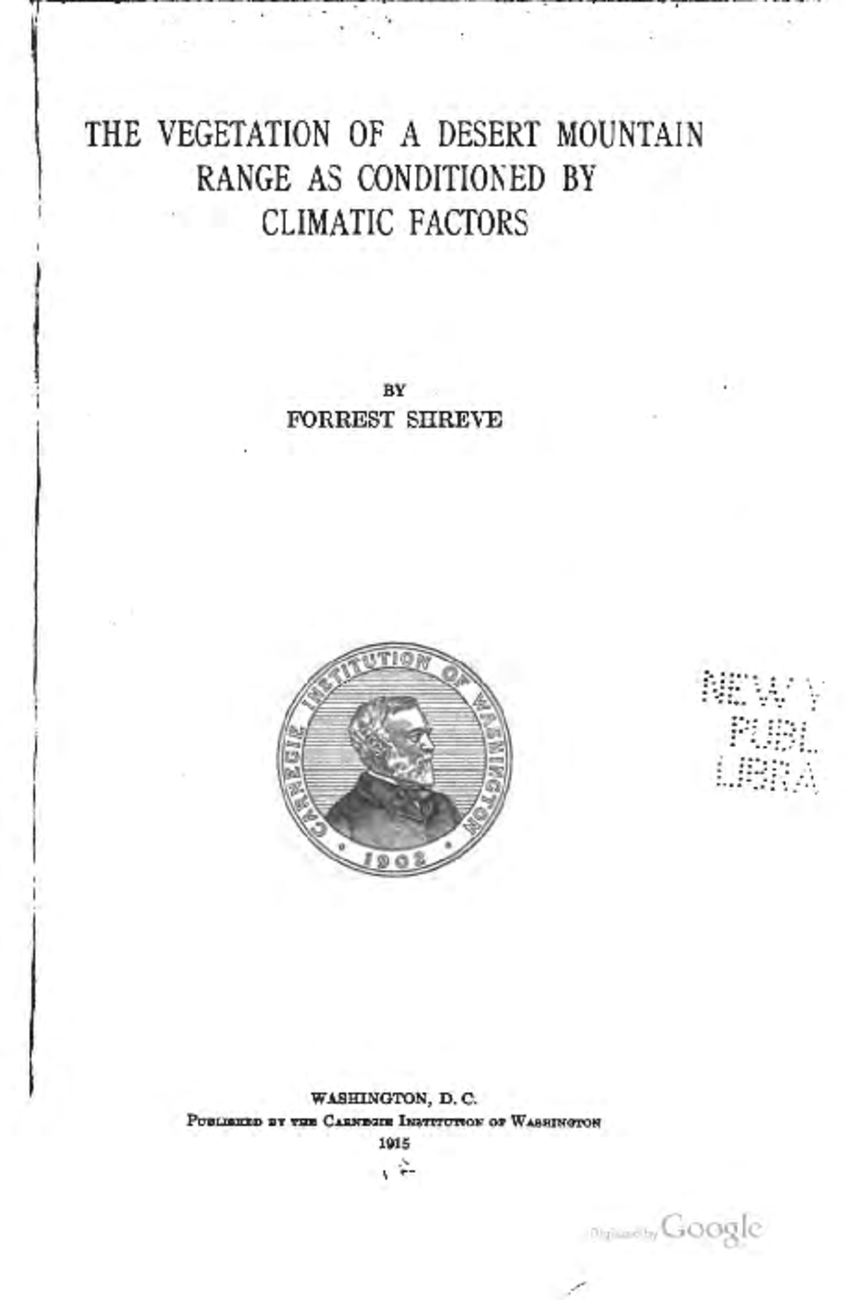The Vegetation of a Desert Mountain Range as Conditioned By Climatic Factors
The southern half of the state of Arizona. may be briefly characterized as a relatively level plain studded with numerous hills and mountains. The plain rises from elevations of a few hundred feet along the Colorado River to as much as 4,500 and 5,000 feet near the New Mexican boundary. The lower elevations follow the Gila, Salt, San Pedro, and other rivers, while the higher plains surround the loftier mountains of the southeastern portion of the State. Between the Colorado River and Tucson there are no mountains of commanding elevation, and the area occupied by the scattered volcanic peaks and ranges is not more
than one-tenth of the total area of the region. To the eastward of Tucson, however, a much greater percentage of the total area is occupied by mountain ranges, a score of which reach elevations of over 8,000 feet. The general topographic configuration of the region has remained unchanged throughout a long period of geological time, and the mountains and hills have been subjected to prolonged erosion, the products of which have served to build up the shelving plains which form the intervening valleys.
Those portions of southern Arizona. which lie below 4,000 feet are covered with a low, open, desert vegetation, while the plains and valleys of higher elevation support a loose carpet of perennial grasses and ephemeral herbs, together with a sparse representation of succulent and semi-succulent types of plants. The higher mountain ranges exhibit a graduated sequence of vegetation from that of the desert valleys, through a scrub of evergreen oaks to forests of pine, spruce, and fir. The bodies of mesophilous vegetation which occupy these isolated mountain summits, and the stages which connect them with the vegetation of the desert, present innumerable phenomena. of the greatest interest to both physiological and floristic plant geography, and form a most fruitful field of investigation.
The Santa Catalina Mountains are one of the most westerly of the high ranges of southeastern Arizona., and rise from an approximate basal elevation of 3,000 feet to a height of 9,150 feet. With respect to their vegetation these mountains are typical of a large number, not only in Arizona. but in southern New Mexico and northern Mexico as well. Their location within 20 miles of Tucson and their ready acces- sibility from the Desert Laboratory have given opportunity for a study of the distribution of their vegetation and for a measurement of some of the physical factors upon which the existence and activities of the vegetation depend. It is the purpose of the present paper to give a brief description of the vegetistic features of the various altitudes and
VEGETATION OF A DESERT MOUNTAIN RANGE. Topographic situations in the Santa Catalina Mountains, to give the results of the climatological instrumentation which has been carried on, and to indicate in so far as possible the manner and degree in which the successive altitudinal stages of vegetation are dependent upon the gradients of climatic change by which they are accompanied.
Some of the instrumental records date from the summer of 1907, the first year in which members of the Desert Laboratory became interested in the mountains, but the principal part of the data to be presented were secured in 1911 and subsequent years. The operation of instruments and the study of vegetation have been made on visits of 5 to 10 days, at intervals between April and October. From three to nine such visits have been made to the mountains in each of the summers since 1910.
The practical exigencies of the work have limited the character of the instrumentation which could be carried out, but have not impaired the accuracy of the data which it was possible to secure. There is no respect in which the results herewith presented may be considered as more than a mere outline of a large and widely ramifying botanical problem. The central interest of the writer has been to determine which of the major environmental factors are responsible for the chief distributional features of the vegetation, and to ascertain something regarding the intensities of the factors responsible for the distributional limits of individual species, and thereby for the limitation of the types of vegetation themselves. Such an inquiry into the correlations exist- ing between physical conditions and the occurrence and activity of plants may do much to explain general vegetistic phenomena, but it does far more to open up the innumerable physiological problems which must be well known at the outset to underlie these correlations.

